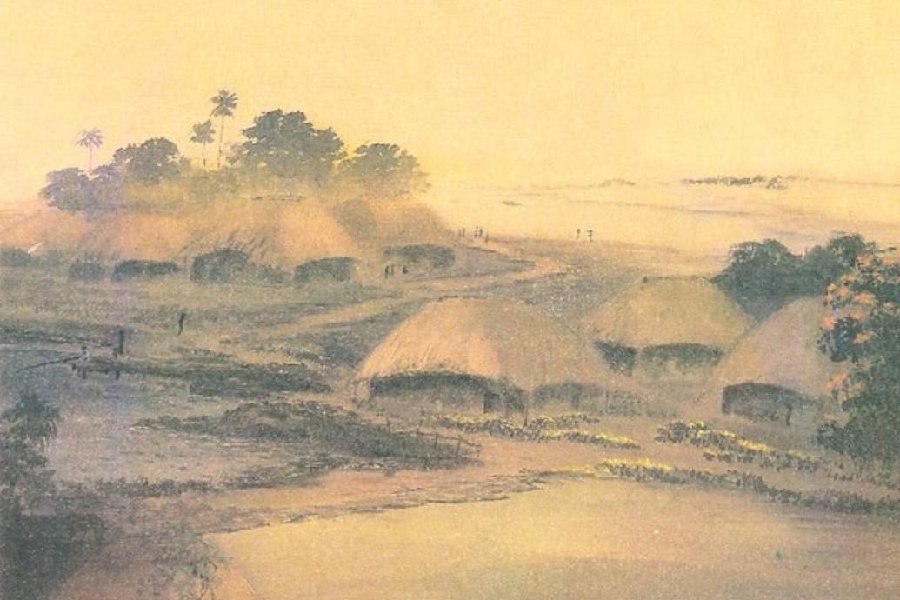Of all the seasons that come to pass, autumn — it is upon us now — is distinctively schizophrenic. This element of splitness can be borne out by a simple exercise. If we were to peer outside, onto the illuminated streets pulsating with the rhythms of the time of the year, we would sense that nearly every ritual — shopping, socialising, leisure — has suddenly become tinged with an unmistakable air of expectancy: something is coming. It could be the goddess; it could be the whiff of a change in personal circumstances; perhaps even a spell of good, peaceful times.
Yet, autumnal iconography is not necessarily suffused with this joie de vivre. On the contrary, artworks created by the masters as well as by ordinary practitioners are often decidedly wistful in their temperament. Consider Gaganendranath Tagore’s painting of autumn that offers a glimpse of Bengal’s countryside — a ceaseless sky, below which lie thatched huts and fields, lit up in tawny, muted light. This image, probably an example of the artist’s work from his First Phase that was rich in depictions of landscapes and settings, articulates a sense of dreamy wistfulness. The association between autumn and ache has proved to be enduring: the ubiquitous images of kaash, clouds and sky that flood the media and social media around this time — pale imitations of an iconic cinematic moment — are similar, albeit inferior, attempts to convey the chord of a peculiar melancholia.
Interestingly, autumn as the season of aches has, over the years, received recognition from the titans of creativity. The “yellow leaves” and “ruined choirs” of a Shakespearean sonnet whisper of an autumnal landscape that is barren. The seasonal allergy of sombreness seems to have well and truly afflicted W.B. Yeats in “When You Are Old” (“When you are old and grey and full of sleep,/ And nodding by the fire, take down this book,/ And slowly read, and dream of the soft look/ Your eyes had once, and of their shadows deep”) as well as Emily Brontë in “Fall, leaves, fall” (“Fall, leaves, fall; die, flowers, away;/ Lengthen night and shorten day”). Keats (“To Autumn”) valiantly refuses to yield to the forlornness that the season wrought on the poetic mind, but even all his optimistic chatter about “ripeness” and “fullness” is offset by a sedate description of autumn being the time of “mists” and “mellow fruitfulness”.
And what of those luminescent minds who wrote with the paintbrush? Vincent van Gogh’s Avenue of Poplars in Autumn and Claude Monet’s Autumn on the Seine, Argenteuil — ochre leaves dominate both frames — are exquisite artistic contemplations on solemnity, that signature autumnal state of mind.
But what is the source, the fount, of this aching that writers and artists have striven to make sense of? The turning of the light — the brilliance of summer making way for the mellowness of autumn — has often been imaginatively used as a compass to measure loss. Thus, in Autumn Light, Pico Iyer makes use of the season’s russet tinge in Japan to explore the ubiquitous experience of passings — mortal and spiritual — and the ways of coping with the resultant absences. This literary and cultural tradition of imagining autumn as a time of anguish cannot, of course, be viewed in isolation. It is the result of a complex interplay of forces — seasonal, agrarian, philosophical/theological and literary. Nature’s preparation for the onset of the cold, barren winter and the corresponding end of the harvest season have coalesced in the fruition of philosophy and theology signifying the end of abundance, which, in turn, has left its imprint on literature and art whose views on autumn are economic, even austere.
Does the autumnal melancholy have to be personal? Could it not be political? Why, then, does Istanbul, in which we see Orhan Pamuk interrogating, brilliantly and conscientiously, the despair that he felt as he explored the nooks and corners of his city in decline, have a special resonance with residents of autumnal cities — Calcutta being one — in the throes of post-colonial/industrial decline?
But autumn, it has been prophesied, should not be dismissed as the repository of just despair. Because, the argument goes, it is a season of ‘in-betweenness’, a time of light and lengthening shadows, the proverbial interregnum between dusk and dawn. Time and light, civilisation has been assured, will turn — inevitably — promising deliverance from despair, replacing ache with ardour. It is this subterranean promise of renewal that those in the autumn of their lives/minds should clutch on to.
Should they?
It is plausible that the most precious gift that autumn bestows upon human thought and artistic sensibilities is the certitude of impermanence, that everything we build, our lives, loves, art, cities, et al, is ultimately transient, and that the most significant — and difficult — of mortal endeavours, a quest that is at once civilisational and individual, one that Iyer embarks on in Autumn Light, involves building the capacity to appreciate the fullness of moments that are, in reality, fleeting.
Its duality notwithstanding, autumn may well be more about endings than beginnings. But in its heralding — awakening — of the sense of an ending, it reminds us of the need to cherish the many roads that had been taken, and the ones forsaken, in the course of our journeys.
uddalak.mukherjee@abp.in










